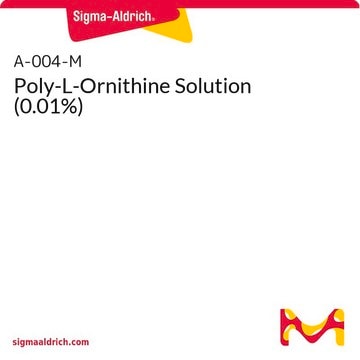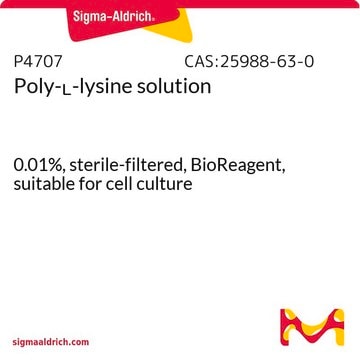P3655
Poly-L-ornithine hydrobromide
suitable for cell culture, Mol wt 30,000-70,000
Sinónimos:
L-Ornithine homopolymer hydrobromide
Seleccione un Tamaño
$54.45
Precio de catálogo$60.50Ahorre 10 %Disponible para envío el04 de abril de 2025Detalles
Seleccione un Tamaño
About This Item
$54.45
Precio de catálogo$60.50Ahorre 10 %Disponible para envío el04 de abril de 2025Detalles
Productos recomendados
Nombre del producto
Poly-L-ornithine hydrobromide, mol wt 30,000-70,000
Formulario
powder
Nivel de calidad
mol peso
30,000-70,000
técnicas
cell culture | mammalian: suitable
color
white to off-white
temp. de almacenamiento
−20°C
cadena SMILES
[Br-].NC(CCCN)C(=O)O.[H+]
InChI
1S/C5H12N2O2.BrH/c6-3-1-2-4(7)5(8)9;/h4H,1-3,6-7H2,(H,8,9);1H
Clave InChI
GWRQMKDBBHFVIZ-UHFFFAOYSA-N
¿Está buscando productos similares? Visita Guía de comparación de productos
Categorías relacionadas
Aplicación
Acciones bioquímicas o fisiológicas
Nota de análisis
Código de clase de almacenamiento
11 - Combustible Solids
Clase de riesgo para el agua (WGK)
WGK 3
Punto de inflamabilidad (°F)
Not applicable
Punto de inflamabilidad (°C)
Not applicable
Equipo de protección personal
Eyeshields, Gloves, type N95 (US)
Elija entre una de las versiones más recientes:
Certificados de análisis (COA)
¿No ve la versión correcta?
Si necesita una versión concreta, puede buscar un certificado específico por el número de lote.
¿Ya tiene este producto?
Encuentre la documentación para los productos que ha comprado recientemente en la Biblioteca de documentos.
Los clientes también vieron
progenitor cells from human cerebrospinal fluid in fetal
cystic myelomeningocele
Artículos
Discover L-ornithine, an important amino acid supplement, explore how L-ornithine is used in CHO and iPSC culture, and discover how poly-L-ornithine is used to enhance cell attachment.
Amino Acid Codon Wheel for fast RNA translation. Find which amino acid is translated from your RNA sequence quickly and easily.
Humankind has utilized protein materials throughout its existence, starting with the use of materials such as wool and silk for warmth and protection from the elements and continuing with the use of recombinant DNA techniques to synthesize proteins with unique and useful properties.
Nuestro equipo de científicos tiene experiencia en todas las áreas de investigación: Ciencias de la vida, Ciencia de los materiales, Síntesis química, Cromatografía, Analítica y muchas otras.
Póngase en contacto con el Servicio técnico









